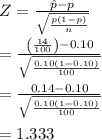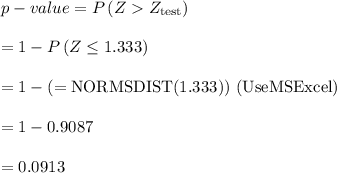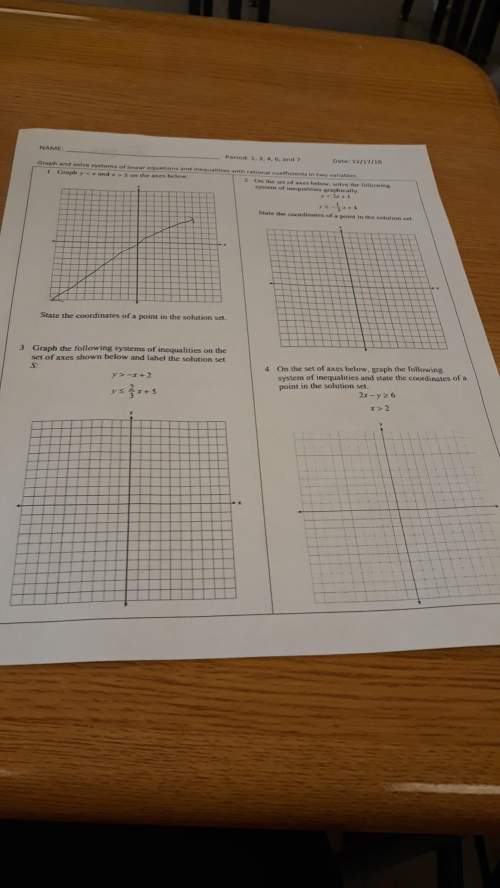
Mathematics, 05.12.2019 04:31 ejsteel2
Amanufacturer of nickel-hydrogen batteries randomly selects 100 nickel plates for test cells, cycles them a specified number of times, and determines that 14 of the plates have blistered.
(a) does this provide compelling evidence for concluding that more than 10% of all plates blister under such circumstances? state and test the appropriate hypotheses using a significance level of .05. in reaching your conclusion, what type of error might you have committed?
(b) if it is really the case that 15% of all plates blister under these circumstances and a sample size 100 is used, how likely is it that the null hypothesis of part (a) will not be rejected by the 0.05 test? answer this question for a sample size of 200.
(c) how many plates would have to be tested to have \(\beta(.15)\) = 0.10 for the test of part (a)?

Answers: 3


Another question on Mathematics


Mathematics, 21.06.2019 19:30
Which inequality has a dashed boundary line when graphed ?
Answers: 2

Mathematics, 21.06.2019 19:30
How long must $542 be invested at a rate of 7% to earn $303.52 in interest? in a easier way
Answers: 1

Mathematics, 22.06.2019 03:30
Paul needs to buy 5/8 pound of peanuts. measure a pound into sixteenths. what measure is equivalent to 5/8 pound
Answers: 1
You know the right answer?
Amanufacturer of nickel-hydrogen batteries randomly selects 100 nickel plates for test cells, cycles...
Questions


Computers and Technology, 03.04.2020 19:56


History, 03.04.2020 19:56




English, 03.04.2020 19:57


History, 03.04.2020 19:57




Health, 03.04.2020 19:58

Mathematics, 03.04.2020 19:58






 be the number of successes in a sample of size.
be the number of successes in a sample of size. be the total sample size.
be the total sample size.





![\beta \left( {p'} \right) = \Phi \left[ {\frac{{\left( {{p_0} - p'} \right) + {Z_{{\rm{Critical}}}}\sqrt {\frac{{{p_0}\left( {1 - {p_0}} \right)}}{n}} }}{{\sqrt {\frac{{p'\left( {1 - p'} \right)}}{n}} }}} \right]{\rm{ }}\left( {{\rm{Since}},{Z_{0.05}} = 1.645} \right)\\\\\beta \left( {0.15} \right) = \Phi \left[ {\frac{{\left( {0.10 - 0.15} \right) + 1.645\sqrt {\frac{{0.10\left( {1 - 0.10} \right)}}{{100}}} }}{{\sqrt {\frac{{0.15\left( {1 - 0.15} \right)}}{{100}}} }}} \right]\\\\ = \Phi \left[ {\frac{{ - 0.05 + 0.04935}}{{0.036}}} \right]\\\\ = \Phi \left[ { - 0.02} \right]\\\\ = \left( {{\rm{ = NORMSDIST( - 0}}{\rm{.02)}}} \right){\rm{ }}\left( {{\rm{Use MS Excel function}}} \right)\\\\ = 0.4927](/tpl/images/0404/0171/f77ba.png)
 will not be rejecting using the
will not be rejecting using the  is 0.4927.
is 0.4927.
![\beta \left( {p'} \right) = \Phi \left[ {\frac{{\left( {{p_0} - p'} \right) + {Z_{{\rm{Critical}}}}\sqrt {\frac{{{p_0}\left( {1 - {p_0}} \right)}}{n}} }}{{\sqrt {\frac{{p'\left( {1 - p'} \right)}}{n}} }}} \right]{\rm{ }}\left( {{\rm{Since}},{Z_{0.05}} = 1.645} \right)\\\\\beta \left( {0.15} \right) = \Phi \left[ {\frac{{\left( {0.10 - 0.15} \right) + 1.645\sqrt {\frac{{0.10\left( {1 - 0.10} \right)}}{{200}}} }}{{\sqrt {\frac{{0.15\left( {1 - 0.15} \right)}}{{200}}} }}} \right]\\\\ = \Phi \left[ { - 0.60} \right]\\\\ = \left( {{\rm{ = NORMSDIST( - 0}}{\rm{.60)}}} \right){\rm{ }}\left( {{\rm{Use MS Excel function}}} \right)\\\\ = 0.2743](/tpl/images/0404/0171/d7d41.png)
![n = {\left[ {\frac{{{Z_\alpha }\sqrt {{p_0}\left( {1 - {p_0}} \right)} + {Z_\beta }\sqrt {p\left( {1 - p} \right)} }}{{p - {p_0}}}} \right]^2}\\\\ = {\left[ {\frac{{1.645\sqrt {0.1\left( {1 - 0.1} \right)} + 1.28\sqrt {0.15\left( {1 - 0.15} \right)} }}{{0.15 - 0.10}}} \right]^2}\\\\ = {\left( {19.01} \right)^2}\\\\ = 362](/tpl/images/0404/0171/40b25.png)



